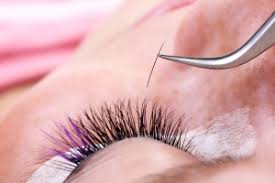PURPOSE:
 Eyelash transplantation can be used to replace eyelashes that have been damaged by injury (car accidents, burns, hair-pulling, etc.), or to cosmetically enhance existing eyelashes that are otherwise short, sparse or otherwise ‘weak.’ The use of single-follicle hair transplantation techniques enables new, living and growing eyelashes to be comfortably and permanently restored to the eyelids.
Eyelash transplantation can be used to replace eyelashes that have been damaged by injury (car accidents, burns, hair-pulling, etc.), or to cosmetically enhance existing eyelashes that are otherwise short, sparse or otherwise ‘weak.’ The use of single-follicle hair transplantation techniques enables new, living and growing eyelashes to be comfortably and permanently restored to the eyelids.
 The procedure is completed in approximately two hours in an office/out-patient setting. Hair follicles from the back of the scalp (‘donor area’) are harvested and then meticulously implanted into the eyelid. Absorb-able stitches are used in the donor area, which remains undetectable both during and after the healing process. Approximately 30 lashes or more can be placed per upper eyelid during a session. The implanted follicles (like the seeds of a plant) will grow and produce new lashes permanently, starting as early as six weeks. The newly growing lashes will possess the same characteristics as the donor scalp hair. The lashes will need to be routinely trimmed and curled. An ‘eyelash perm’ is recommended for those patients with straighter hair. Please note: lower lid eyelash transplantation is not performed. Medication for any mild discomfort is provided as well as medication to reduce swelling. It is recommended that the patient have transportation to and from the office. Several hours after the procedure, some soreness may be experienced in the donor area, as well as the eyelids. Protective goggles (provided) should be worn while sleeping. Patients will be instructed in the gentle post-op care and cleansing of the eyelid and lashes. Mild swelling and/or bruising in the eyelid area may last up to two weeks. The absorb-able stitches in the donor area may take up to one month to dissolve completely. Mascara and other eye-makeup should be completely avoided during the immediate post-op healing period (approx. 1 week). Some patients may require an additional session of eyelash transplantation to reach their restoration goals.
The procedure is completed in approximately two hours in an office/out-patient setting. Hair follicles from the back of the scalp (‘donor area’) are harvested and then meticulously implanted into the eyelid. Absorb-able stitches are used in the donor area, which remains undetectable both during and after the healing process. Approximately 30 lashes or more can be placed per upper eyelid during a session. The implanted follicles (like the seeds of a plant) will grow and produce new lashes permanently, starting as early as six weeks. The newly growing lashes will possess the same characteristics as the donor scalp hair. The lashes will need to be routinely trimmed and curled. An ‘eyelash perm’ is recommended for those patients with straighter hair. Please note: lower lid eyelash transplantation is not performed. Medication for any mild discomfort is provided as well as medication to reduce swelling. It is recommended that the patient have transportation to and from the office. Several hours after the procedure, some soreness may be experienced in the donor area, as well as the eyelids. Protective goggles (provided) should be worn while sleeping. Patients will be instructed in the gentle post-op care and cleansing of the eyelid and lashes. Mild swelling and/or bruising in the eyelid area may last up to two weeks. The absorb-able stitches in the donor area may take up to one month to dissolve completely. Mascara and other eye-makeup should be completely avoided during the immediate post-op healing period (approx. 1 week). Some patients may require an additional session of eyelash transplantation to reach their restoration goals.
RESULTS:
Implanted lashes typically shed within two weeks, then begin to regrow starting at six weeks. Approximately 80-90% of the transplanted lashes can be expected to grow. A complete cosmetic result can be expected by 12 months.
RISKS:
 As with any cosmetic procedure, there are certain risks that are known and unknown. The risks of eyelash transplantation are considered to be similar to that of other minor eyelid surgery and depend on a number of factors. All patients should discuss their expectations with their physician prior to undergoing any procedure.
As with any cosmetic procedure, there are certain risks that are known and unknown. The risks of eyelash transplantation are considered to be similar to that of other minor eyelid surgery and depend on a number of factors. All patients should discuss their expectations with their physician prior to undergoing any procedure.
Eyelash transplantation, trichotillomania (hair-pulling) and trauma: Eyelash transplantation can be used to restore eyelashes damaged by trauma, ‘over-plucking,’ or even the hair pulling disease, trichotillomania. However, patients with untreated or active trichotillomania cannot undergo eyelash transplantation. If the trichotillomania remains untreated or recurs, hair pulling can damage the transplanted lashes.
Eyelash transplantation and alopecia totalis/universalis and other eyelid conditions:
Patients with alopecia totalis, alopecia universalis, or active eyelid inflammation or disease are not candidates for eyelash transplantation.
***Fell free to share and comment***
PROCEDURE:
RESULTS:
Implanted lashes typically shed within two weeks, then begin to regrow starting at six weeks. Approximately 80-90% of the transplanted lashes can be expected to grow. A complete cosmetic result can be expected by 12 months.
RISKS:
Eyelash transplantation, trichotillomania (hair-pulling) and trauma: Eyelash transplantation can be used to restore eyelashes damaged by trauma, ‘over-plucking,’ or even the hair pulling disease, trichotillomania. However, patients with untreated or active trichotillomania cannot undergo eyelash transplantation. If the trichotillomania remains untreated or recurs, hair pulling can damage the transplanted lashes.
Eyelash transplantation and alopecia totalis/universalis and other eyelid conditions:
Patients with alopecia totalis, alopecia universalis, or active eyelid inflammation or disease are not candidates for eyelash transplantation.
***Fell free to share and comment***
No comments:
Post a Comment